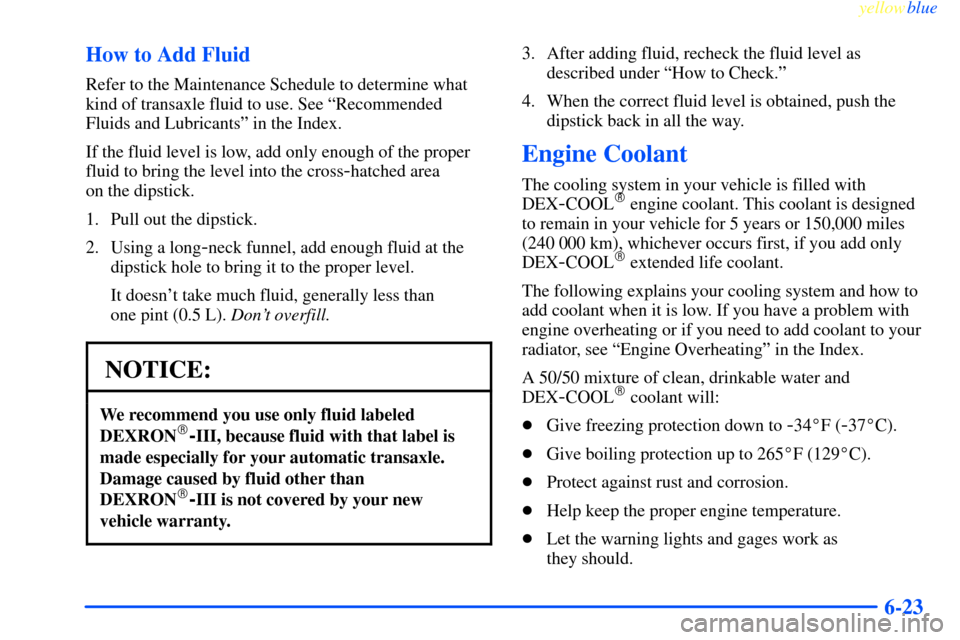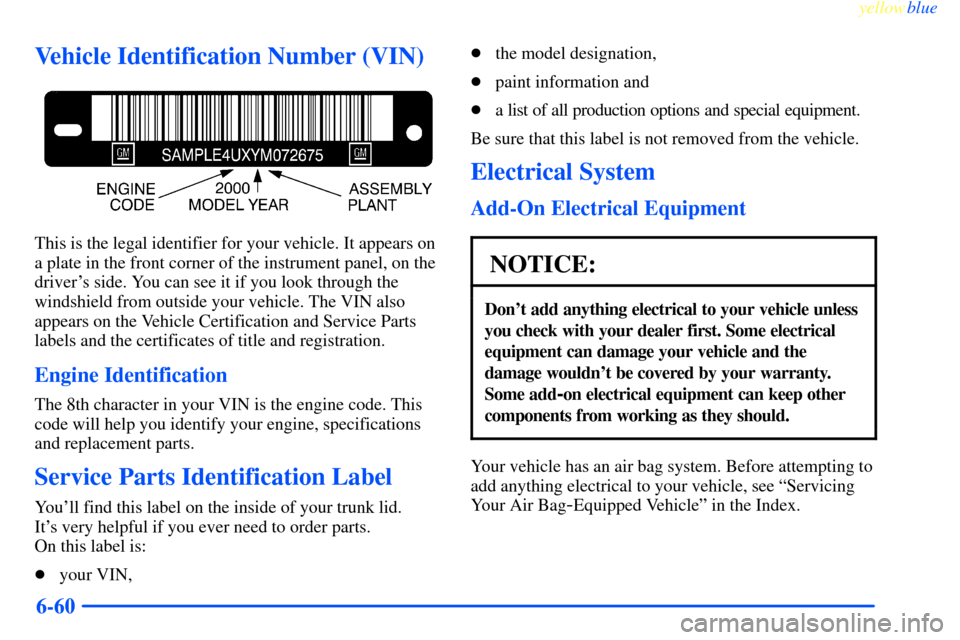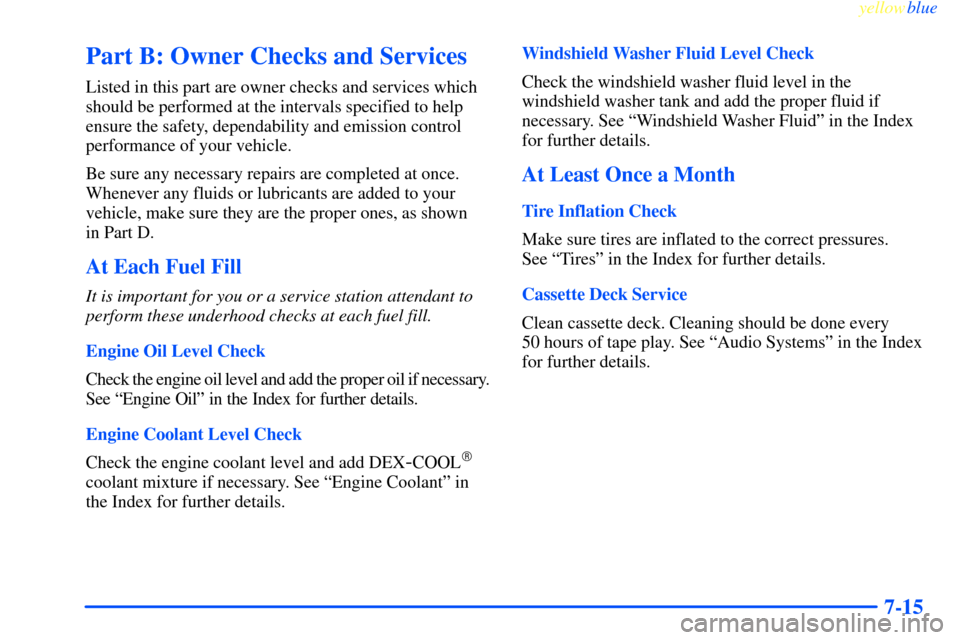Page 279 of 365
yellowblue
6-22
Then, without shutting off the engine, follow these steps:
3400 (Code E)
V6 Engine 3800 (Code K)
V6 Engine
6. The transaxle fluid dipstick handle is the red loop
near the back of the engine. Pull out the dipstick and
wipe it with a clean rag or paper towel.
7. Push it back in all the way, wait three seconds and
then pull it back out again.
3400 (Code E)
V6 Engine3800 (Code K)
V6 Engine
8. Check both sides of the dipstick, and read the
lower level. The fluid level must be in the
cross
-hatched area.
9. If the fluid level is in the acceptable range, push the
dipstick back in all the way.
Page 280 of 365

yellowblue
6-23 How to Add Fluid
Refer to the Maintenance Schedule to determine what
kind of transaxle fluid to use. See ªRecommended
Fluids and Lubricantsº in the Index.
If the fluid level is low, add only enough of the proper
fluid to bring the level into the cross
-hatched area
on the dipstick.
1. Pull out the dipstick.
2. Using a long
-neck funnel, add enough fluid at the
dipstick hole to bring it to the proper level.
It doesn't take much fluid, generally less than
one pint (0.5 L). Don't overfill.
NOTICE:
We recommend you use only fluid labeled
DEXRON�-III, because fluid with that label is
made especially for your automatic transaxle.
Damage caused by fluid other than
DEXRON
�-III is not covered by your new
vehicle warranty.
3. After adding fluid, recheck the fluid level as
described under ªHow to Check.º
4. When the correct fluid level is obtained, push the
dipstick back in all the way.
Engine Coolant
The cooling system in your vehicle is filled with
DEX
-COOL� engine coolant. This coolant is designed
to remain in your vehicle for 5 years or 150,000 miles
(240 000 km), whichever occurs first, if you add only
DEX
-COOL� extended life coolant.
The following explains your cooling system and how to
add coolant when it is low. If you have a problem with
engine overheating or if you need to add coolant to your
radiator, see ªEngine Overheatingº in the Index.
A 50/50 mixture of clean, drinkable water and
DEX
-COOL� coolant will:
�Give freezing protection down to
-34�F (-37�C).
�Give boiling protection up to 265�F (129�C).
�Protect against rust and corrosion.
�Help keep the proper engine temperature.
�Let the warning lights and gages work as
they should.
Page 282 of 365
yellowblue
6-25
NOTICE:
If you use an improper coolant mixture, your
engine could overheat and be badly damaged.
The repair cost wouldn't be covered by your
warranty. Too much water in the mixture can
freeze and crack the engine, radiator, heater core
and other parts.
If you have to add coolant more than four times a year,
have your dealer check your cooling system.
NOTICE:
If you use the proper coolant, you don't have to
add extra inhibitors or additives which claim to
improve the system. These can be harmful.
Checking Coolant
The coolant recovery tank is located between the power
steering fluid reservoir and the underhood fuse block on
the passenger's side of the engine compartment.
The vehicle must be on a level surface. When your
engine is cold, the coolant level should be at the
COLD mark or a little higher. When your engine is
warm, the level should be up to the HOT mark
or a little higher.
Page 284 of 365
yellowblue
6-27
Radiator Pressure Cap
NOTICE:
Your radiator cap is a 15 psi (105 kPa)
pressure
-type cap and must be tightly installed to
prevent coolant loss and possible engine damage
from overheating. Be sure the arrows on the cap
line up with the overflow tube on the radiator
filler neck.
Power Steering Fluid
The power steering fluid reservoir is located toward the
rear of the engine compartment, on the passenger's side.
When to Check Power Steering Fluid
It is not necessary to regularly check power steering fluid
unless you suspect there is a leak in the system or you hear
an unusual noise. A fluid loss in this system could indicate
a problem. Have the system inspected and repaired.
Page 285 of 365

yellowblue
6-28 How to Check Power Steering Fluid
When the engine compartment is cool, wipe the cap and
the top of the reservoir clean, then unscrew the cap and
wipe the dipstick with a clean rag. Replace the cap and
completely tighten it. Then remove the cap again and
look at the fluid level on the dipstick.
When the 3400 V6 engine compartment is hot, the level
should be at the ªHº mark. When it's cold, the level
should be at the ªCº mark. If the fluid is at the
ADD mark, you should add fluid.
For the 3800 V6 engine, the level should be at the
HOT mark when the engine compartment is hot.
If the fluid is at the ADD mark, you should add fluid.
What to Use
To determine what kind of fluid to use, see
ªRecommended Fluids and Lubricantsº in the Index.
Always use the proper fluid. Failure to use the proper
fluid can cause leaks and damage hoses and seals.
Windshield Washer Fluid
What to Use
When you need windshield washer fluid, be sure to read
the manufacturer's instructions before use. If you will be
operating your vehicle in an area where the temperature
may fall below freezing, use a fluid that has sufficient
protection against freezing.
Adding Washer Fluid
When this message is
displayed, it means the
vehicle is low on windshield
washer fluid. You should
add more windshield
washer fluid soon.
Page 317 of 365

yellowblue
6-60
Vehicle Identification Number (VIN)
This is the legal identifier for your vehicle. It appears on
a plate in the front corner of the instrument panel, on the
driver's side. You can see it if you look through the
windshield from outside your vehicle. The VIN also
appears on the Vehicle Certification and Service Parts
labels and the certificates of title and registration.
Engine Identification
The 8th character in your VIN is the engine code. This
code will help you identify your engine, specifications
and replacement parts.
Service Parts Identification Label
You'll find this label on the inside of your trunk lid.
It's very helpful if you ever need to order parts.
On this label is:
�your VIN,�the model designation,
�paint information and
�a list of all production options and special equipment.
Be sure that this label is not removed from the vehicle.
Electrical System
Add-On Electrical Equipment
NOTICE:
Don't add anything electrical to your vehicle unless
you check with your dealer first. Some electrical
equipment can damage your vehicle and the
damage wouldn't be covered by your warranty.
Some add
-on electrical equipment can keep other
components from working as they should.
Your vehicle has an air bag system. Before attempting to
add anything electrical to your vehicle, see ªServicing
Your Air Bag
-Equipped Vehicleº in the Index.
Page 325 of 365

yellowblue
6-68
Replacement Bulbs
Exterior Lamps Bulb Number
Back
-Up 921. . . . . . . . . . . . . . . . . . . . . . . . . . . . . . . .
Front Park/Turn Signal 3357NAK or 3457 NAK. . . .
Headlamp, High
-Beam 9005. . . . . . . . . . . . . . . . . . .
Headlamp, Low
-Beam 9006. . . . . . . . . . . . . . . . . . . .
Stop/Tail/Turn Signal 3057. . . . . . . . . . . . . . . . . . . . .
Fog Lamp 896 or 893*. . . . . . . . . . . . . . . . . . . . . . . . .
*check number on old bulb for correct replacement
bulb number
Rear Sidemarker 194. . . . . . . . . . . . . . . . . . . . . . . . .
Interior Lamps Bulb Number
Dome 10230955. . . . . . . . . . . . . . . . . . . . . . . . . . . .
Rear Compartment Courtesy 912. . . . . . . . . . . . . . .
Capacities and Specifications
Automatic Transaxle
Pan Removal and Replacement 7.4 quarts (7.0 L). . .
After Complete Overhaul 10.0 quarts (9.5 L). . . . . . .
When draining/replacing converter, more fluid will
be needed.
Cooling System Including Reservoir
3400 (Code E) V6 11.3 quarts (10.7 L). . . . . . . . . . . .
3800 (Code K) V6 11.7 quarts (11.0 L). . . . . . . . . . . .
Refrigerant,
Air Conditioning1.88 lbs. (0.85 kg) . . . . . . . . . . . .
Engine Crankcase
- Oil and Filter Change
3400 (Code E) V6 4.5 quarts (4.3 L). . . . . . . . . . . . .
3800 (Code K) V6 4.5 quarts (4.3 L). . . . . . . . . . . . .
Fuel Tank17.0 gallons (64.3 L) . . . . . . . . . . . . . . . . .
Note: All capacities are approximate. When adding, be
sure to fill to the approximate level, as recommended in
this manual. See ªRecommended Fluids and Lubricantsº
in the Index.
Page 342 of 365

yellowblue
7-15
Part B: Owner Checks and Services
Listed in this part are owner checks and services which
should be performed at the intervals specified to help
ensure the safety, dependability and emission control
performance of your vehicle.
Be sure any necessary repairs are completed at once.
Whenever any fluids or lubricants are added to your
vehicle, make sure they are the proper ones, as shown
in Part D.
At Each Fuel Fill
It is important for you or a service station attendant to
perform these underhood checks at each fuel fill.
Engine Oil Level Check
Check the engine oil level and add the proper oil if necessary.
See ªEngine Oilº in the Index for further details.
Engine Coolant Level Check
Check the engine coolant level and add DEX
-COOL�
coolant mixture if necessary. See ªEngine Coolantº in
the Index for further details.Windshield Washer Fluid Level Check
Check the windshield washer fluid level in the
windshield washer tank and add the proper fluid if
necessary. See ªWindshield Washer Fluidº in the Index
for further details.
At Least Once a Month
Tire Inflation Check
Make sure tires are inflated to the correct pressures.
See ªTiresº in the Index for further details.
Cassette Deck Service
Clean cassette deck. Cleaning should be done every
50 hours of tape play. See ªAudio Systemsº in the Index
for further details.